Can We Upload File on Semantic Media Wiki?
| | Note: When you edit this page, you lot agree to release your contribution under the CC0. See Public Domain Help Pages for more than info. | |
This page explains the prototype syntax when editing the wiki. You or another user must ordinarily upload an epitome earlier you can use it on a folio.
Images that are stored on a MediaWiki server are usually rendered past using the File: namespace prefix (but the legacy Paradigm: namespace prefix is still supported as a synonym) as the target of a MediaWiki link. The alternate Media: namespace prefix is also usable to reference the original media file content (for rendering or downloading it separately, out of any MediaWiki page).
Supported media types for images
The following file formats are supported by default:
-
.jpgor.jpeg- bitmap image compressed in the standard JPEG format (this lossy format is virtually suitable for photographs). -
.png- bitmap image in the Portable Network Graphics format (specified by the W3 Consortium). -
.gif- bitmap prototype in the legacy Graphics Interchange Format.
Other formats used on Wikimedia, and normally enabled elsewhere (these may require actress set-upwards beyond what is enabled by default):
-
.svg- scalable image in the Scalable Vector Graphics format (specified past the W3 Consortium). See Transmission:Image Administration#SVG. -
.tiff- Tagged epitome format. Often used for high-resolution archival photographs. Oft used with Extension:PagedTiffHandler . -
.ogg,.oga,.ogv- Ogg multimedia (audio or video). Not an image format, but treated similarly. Often used with Extension:TimedMediaHandler -
.pdf- multipaged documents in the Portable Document Format (initially specified by Adobe). Often used in conjunction with Extension:PdfHandler -
.djvu- multipaged bitmap documents in the DejaVu format (virtually frequently, scans of books). Come across Manual:How to apply DjVu with MediaWiki- Only a single page of a
.pdfor.djvufile is shown at one fourth dimension.
- Only a single page of a
Other media types may be supported, just it may non be possible to display them inline.
Rendering a single paradigm
Syntax
The full syntax for displaying an image is:
[[File:filename.extension|options|explanation]]
where options can be nothing or more than of the following, separated by pipes (|):
For best results, use lower case for all of the options listed beneath (east.g. use thumb, not Pollex). Some options work when started with an majuscule, but most are ignored. (See job T216566 for details.)
- Format option: ane of border and/or frameless, frame (or framed), thumb (or thumbnail). If multiple options are present, image rendering may be unexpected.
- Controls how the rendered image is formatted and embedded in the balance of the page.
When multiple of the above options are used, results tin exist unexpected, and no fault is displayed. See task T264464 for details.
- Resizing option: one of
- {width} px — Resizes the image to fit within the given maximum width in pixels, without restricting its acme. (Simply whole-number pixel values are supported. A space character between the width value and "px" is permitted.)
- 10 {height} px — Resizes the image to fit within the given maximum height in pixels, without restricting its width. Only whole-number pixel values are supported. A infinite character between the pinnacle value and "px" is permitted.
- {width} x {height} px — Resizes the image to fit within the given width and elevation in pixels. Only whole-number pixel values are supported. A space character between the width value and "px" is permitted.
- upright — Resizes an image to fit within reasonable dimensions, co-ordinate to user preferences (suitable for images whose top is larger than width). Setting
|upright=1.0|volition display the image at the user'south default image width.|upright=2.0|volition display the image at double the user's default width.
- The image will always retain its aspect ratio.
- Images in non-scalable media types can be reduced in size, just not increased; e.yard., bitmap images cannot be scaled up.
- The
uprightsetting does not require an equals sign, i.east.|upright 2.0|works the same every bit|upright=2.0|. - When used without a value or an equals sign (east.thou.,
|upright|), defaults to|upright=0.75|(although|upright=|is the same as|upright=1.0|) - If both
|upright|and|upright=number|are present, the first|upright|volition be ignored. See chore T216003 for details. - If there is a space character between "upright" and the equals sign (due east.g.
|upright =number|), or if the "upright" value contains non-numeric characters, theuprightvalue will be ignored. Run into job T216003 for details. - The default maximum size depends on the format and the internal prototype dimensions (according to its media type).
- Horizontal alignment option: ane of left, right, center, none. If multiple of these options are present, only the kickoff one will exist used
- Controls the horizontal alignment (and inline/cake or floating styles) of the paradigm within a text (no default value).
- Vertical alignment option: one of baseline, sub, super, top, text-height, center, lesser, text-bottom
- Controls the vertical alignment of a non-floating inline image with the text earlier or afterwards the image, and in the aforementioned cake (the default vertical alignment is middle).
- Link choice: one of
- If there is a infinite character between
linkand the equals sign, the link argument will be treated equally a caption. - Including some HTML character equivalents, similar
%22for", can cause the link statement to be treated equally a explanation (see phabricator:T216003). - ! for MW 1.24 and lower: If you prepare
|link=|(empty), then notitlewill be rendered. (See phabricator:T23454.)
- If there is a infinite character between
- Other specific options:
- alt= {alternative text} — (MediaWiki 1.14+) Defines the alternative text (maps to the HTML aspect
alt="..."of the generated< img />chemical element) of an image that will be rendered if either the referenced prototype cannot be downloaded and embedded, or if the support media must apply the culling description text (e.g. when using a Braille reader or with accessibility options set by the user in its browser).
- If there is a space graphic symbol between
altand the equals sign, the alt statement volition be treated as a caption.
- page= {number} — Renders the specified page number (currently but applicative when showing a .djvu or .pdf file).
- course= {html form} — (MediaWiki i.20+) Defines classes (maps to the HTML attribute
class="..."of the generated< img />element). - lang= {language lawmaking} — (MediaWiki one.22+) For SVG files containing <switch> statements varying on a systemLanguage aspect, selects what language to render the file in. The default is the page language (defaults to project default linguistic communication on most projects).
- alt= {alternative text} — (MediaWiki 1.14+) Defines the alternative text (maps to the HTML aspect
If a parameter does non lucifer whatsoever of the other possibilities, it is assumed to be the caption text. If more than one not-parameter string is present, the concluding non-parameter string volition be used every bit the caption. Caption text shows below the image in thumb and frame formats, or as tooltip text in any other format. Caption text displayed in the pollex and frame formats may contain wiki links and other formatting. MediaWiki extensions tin can add additional options.
If 'alt' is not specified and a explanation is provided, the culling text will be created automatically from the caption, stripped of formatting, except when in thumb or frame fashion since the caption is already readable by screen readers in that case.
The actual default behavior is to brandish the multimedia file in its full size. This may lead to responsive problems if the file width is bigger than the folio. Run into the Task phab:T113101 for further details.
Format
The following table shows the effect of all bachelor formats.
| Description | Y'all blazon | You get |
|---|---|---|
| no format specified Rendered as a floating block: no Rendered inline: yeah Rendered caption: no | ... text text text [[File:example.jpg|caption]] text text text ... | ... text text text |
| edge results in a very small gray border Rendered as a floating block: no Rendered inline: yeah Rendered caption: no | ... text text text [[File:example.jpg|border|explanation]] text text text ... | ... text text text |
| frameless, like thumbnail, respect user preferences for image width, but without border and no correct float Rendered as a floating block: no Rendered inline: yes Rendered caption: no | ... text text text [[File:instance.jpg|frameless|explanation]] text text text ... | ... text text text |
| frameless and border Rendered as a floating cake: no Rendered inline: yes Rendered explanation: no | ... text text text [[File:example.jpg|frameless|edge|caption]] text text text ... | ... text text text |
| frame Rendered as a floating cake: yes Rendered inline: no Rendered caption: yes | ... text text text [[File:example.jpg|frame|caption]] text text text ... | ... text text text  text text text ... |
| thumb or thumbnail Rendered as a floating block: yes Rendered inline: no Rendered explanation: yes | ... text text text [[File:instance.jpg|pollex|caption]] text text text ... | ... text text text 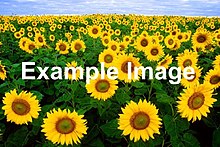 text text text ... |
When the peak of an image in thumbnail is bigger than its width (i.east. in portrait orientation rather than mural) and you find information technology too large, y'all may endeavor the option upright=N, where N is the image's aspect ratio (its width divided by its height, defaulting to 0.75). The culling is to specify the desired maximum height (in pixels) explicitly.
Note that by writing thumb={filename}, you tin employ a unlike prototype for the thumbnail.
Size and frame
Among dissimilar formats, the outcome of the size parameter may be different, as shown beneath.
- For how it appears when its size is not specified, meet Format section in a higher place.
- When the format is not specified, or only
bordered, the size tin be both reduced and enlarged to any specified size. - In the examples beneath, the original size of the image is 400 × 267 pixels.
- An image with
framee'er ignores the size specification, the original image volition be reduced if it exceeds the maximum size defined in user preferences. - The size of an image with
thumborframelesstin be reduced, but cannot be enlarged beyond the original size of the image.
| Format | Reduced | Enlarged |
|---|---|---|
| (not specified) | [[File:example.jpg|50px]] | [[File:example.jpg|500px]] |
| border | [[File:case.jpg|border|50px]] | [[File:example.jpg|border|500px]] |
| frame | [[File:example.jpg|frame|50px]]  | [[File:example.jpg|frame|500px]]  |
| thumb | [[File:instance.jpg|thumb|50px]] | [[File:case.jpg|thumb|500px]]  |
| frameless | [[File:example.jpg|frameless|50px]] | [[File:example.jpg|frameless|500px]] |
Horizontal alignment
Note that when using the frame or thumb[nail] formats, the default horizontal alignment will be right for left-to-right languages, and left for right-to-left languages.
| Description | Y'all type | Yous get |
|---|---|---|
| no horizontal alignment specified, or default alignment Rendered every bit a floating block: no Rendered inline: yes | ... text text text [[File:instance.jpg|100px|explanation]] text text text ... | ... text text text |
| specify horizontal alignment every bit: none Rendered as a floating block: no Rendered inline: no | ... text text text [[File:example.jpg|none|100px|caption]] text text text ... | ... text text text  text text text ... |
| specify horizontal alignment as: center Rendered every bit a floating block: no Rendered inline: no | ... text text text [[File:case.jpg|centre|100px|caption]] text text text ... | ... text text text  text text text ... |
| specify horizontal alignment as: left Rendered as a floating block: yeah Rendered inline: no | ... text text text [[File:example.jpg|left|100px|explanation]] text text text ... | ... text text text  text text text ... |
| specify horizontal alignment as: right Rendered as a floating block: yep Rendered inline: no | ... text text text [[File:instance.jpg|right|100px|explanation]] text text text ... | ... text text text  text text text ... |
Vertical alignment
The vertical alignment options take outcome only if the image is rendered as an inline element and is not floating. They alter the way the inlined image will be vertically aligned with the text nowadays in the aforementioned block before and/or later this image on the same rendered row.
Note that the rendered line of text where inline images are inserted (and the lines of text rendered after the electric current i) may exist moved downwardly (this will increase the line-tiptop conditionally by additional line spacing, only as it may occur with spans of text with variable font sizes, or with superscripts and subscripts) to permit the image height to exist fully displayed with this alignment constraint.
Toggle source code view
< p mode = "edge:1px solid #AAA;padding:0;font-size:150%;line-height:2" > < span fashion = "groundwork:#FFF;color:#000;text-ornament:overline" >< u >< del >text</ del > '''acme:''' [[File:Example.jpg|20px|top]] [[File:Example.jpg|40px|height]] [[File:Instance.jpg|100px|elevation]] < del >text</ del ></ u ></ span ></ p > < p style = "edge:1px solid #AAA;padding:0;font-size:150%;line-peak:ii" > < span style = "background:#FFF;color:#000;text-decoration:overline" >< u >< del >text</ del > '''text-summit:''' [[File:Case.jpg|20px|text-summit]] [[File:Case.jpg|40px|text-top]] [[File:Example.jpg|100px|text-acme]] < del >text</ del ></ u ></ bridge ></ p > < p fashion = "border:1px solid #AAA;padding:0;font-size:150%;line-pinnacle:two" > < bridge fashion = "background:#FFF;colour:#000;text-decoration:overline" >< u >< del >text</ del > < sup >super:</ sup > [[File:Instance.jpg|20px|super]] [[File:Example.jpg|40px|super]] [[File:Instance.jpg|100px|super]] < del >text</ del ></ u ></ span ></ p > < p style = "border:1px solid #AAA;padding:0;font-size:150%;line-pinnacle:ii" > < span style = "background:#FFF;colour:#000;text-ornament:overline" >< u >< del >text</ del > '''baseline:''' [[File:Example.jpg|20px|baseline]] [[File:Example.jpg|40px|baseline]] [[File:Example.jpg|100px|baseline]] < del >text</ del ></ u ></ span ></ p > < p style = "border:1px solid #AAA;padding:0;font-size:150%;line-superlative:2" > < span style = "background:#FFF;color:#000;text-decoration:overline" >< u >< del >text</ del > < sub >'''sub:'''</ sub > [[File:Instance.jpg|20px|sub]] [[File:Example.jpg|40px|sub]] [[File:Example.jpg|100px|sub]] < del >text</ del ></ u ></ bridge ></ p > < p style = "border:1px solid #AAA;padding:0;font-size:150%;line-superlative:2" > < span style = "background:#FFF;color:#000;text-decoration:overline" >< u >< del >text</ del > '''default:''' [[File:Example.jpg|20px]][[File:Example.jpg|40px]] [[File:Example.jpg|100px]] < del >text</ del ></ u ></ span ></ p > < p style = "edge:1px solid #AAA;padding:0;font-size:150%;line-height:2" > < span way = "background:#FFF;color:#000;text-decoration:overline" >< u >< del >text</ del > '''centre:''' [[File:Example.jpg|20px|centre]] [[File:Case.jpg|40px|middle]] [[File:Instance.jpg|100px|middle]] < del >text</ del ></ u ></ span ></ p > < p fashion = "border:1px solid #AAA;padding:0;font-size:150%;line-tiptop:2" > < span style = "background:#FFF;color:#000;text-decoration:overline" >< u >< del >text</ del > '''text-bottom:''' [[File:Example.jpg|20px|text-bottom]] [[File:Example.jpg|40px|text-lesser]] [[File:Example.jpg|100px|text-bottom]] < del >text</ del ></ u ></ span ></ p > < p mode = "border:1px solid #AAA;padding:0;font-size:150%;line-height:ii" > < span style = "background:#FFF;color:#000;text-decoration:overline" >< u >< del >text</ del > '''bottom:'' [[File:Case.jpg|20px|bottom]] [[File:Example.jpg|40px|bottom]] [[File:Instance.jpg|100px|bottom]] < del >text</ del ></ u ></ span ></ p >
To bear witness the alignment result more clearly, the text spans are overlined and underlined, the font-size is increased to 200%, and the paragraph cake is outlined with a thin edge; additionally images of different sizes are aligned:
text peak: ![]()
![]()

text
text text-top: ![]()
![]()

text
text super: ![]()
![]()

text
text baseline: ![]()
![]()

text
text sub: ![]()
![]()

text
text default: ![]()
![]()

text
text middle: ![]()
![]()

text
text text-bottom: ![]()
![]()

text
text bottom: ![]()
![]()

text
Notes:
- The "centre" vertical alignment position of the paradigm (which is also the default) usually refers to the middle between the x-height and the baseline of the text (on which the vertical middle of the prototype will exist aligned, and on which normally the text may be overstroke), but non to the heart of the line-height of the font-meridian that refers to the infinite between the "text-meridian" and "text-lesser" positions ; the font-top excludes:
- the additional line separation spacing commonly divided equally into two line-margins (here 0.5em, according to line-tiptop set to 200%) above and below the font-top).
- the boosted line spacing which may be added by superscripts and subscripts.
- However, if the image top causes its top or bottom position to go above or below the normal total line-height of text, the middle position will be adjusted after the increasing the top and/or bottom line-margins so that the image tin can fit and marshal properly, and all images (including those with smaller heights) will be vertically centered on the adjusted middle position (for computing the effective line-pinnacle, the text of each rendered row with the larger font-height will exist considered).
- The "text-top" and "text-bottom" alignment positions too excludes the actress line spacing added past superscripts and subscripts, but non the additional line-spacing divers past the line-height.
- The "top" and "bottom" alignment positions take into account all these extra line spacings (including superscripts and subscripts, if they are present in a rendered line span). When the prototype alignment constrains the image to abound above or below the normal line-spacing, and the paradigm is non absolutely positioned, the image will crusade the "top" and "lesser" positions to be adjusted (just like superscripts and subscripts), and so the effective line-height betwixt rendered lines of text will be higher.
- The "underline", "overline" and "overstrike" text-decoration positions should be somewhere within these two limits and may depend on the blazon and pinnacle of fonts used (the superscript and subscript styles may be taken into account in some browsers, just commonly these styles are ignored and the position of these decorations may non exist adjusted); and so these decorations normally don't affect the vertical position of images, relatively to the text.
Stopping the text flow
On occasion it is desirable to terminate text (or other inline not-floating images) from flowing around a floating image. Depending on the spider web browser's screen resolution and such, text flow on the correct side of an paradigm may cause a department header (for example, == My Header ==) to appear to the right of the epitome, instead of beneath it, as a user may expect. The text flow tin exist stopped by placing < br articulate = all > (or if you prefer, < div style = "clear: both" ></ div > ) earlier the text that should start beneath the floating image. (This may also be done without an empty line by wrapping the department with the floating images with < div mode = "overflow: hidden" >…</ div > , which clears all floats within the div element.)
All images rendered as blocks (including non-floating centered images, left- or correct-floating images, as well as framed or thumbnailed floating images) are implicitly breaking the surrounding lines of text (terminating the electric current block of text before the image, and creating a new paragraph for the text after them). They will and then stack vertically along their left or right alignment margin (or along the center line between these margins for centered images).
Altering the default link target
The following table shows how to alter the link target (whose default is the image description page) or how to remove it. Changing the link does not alter the format described in the previous sections.
| Description | You type | Y'all become |
|---|---|---|
| internal link | ... text text text [[File:example.jpg|link=Chief Page|caption]] text text text ... | ... text text text |
| external link | ... text text text [[File:case.jpg|link=http://wikipedia.org/wiki/Examination|explanation]] text text text ... | ... text text text |
| no link (external or file page) | ... text text text [[File:instance.jpg|link=|caption]] text text text ... | ... text text text |
Warning:
- The licencing requirements on your wiki may non allow you to remove all links to the clarification page that displays the required authors attributions, the copyrights statements, the applicable licencing terms, or a more complete description of the rendered image (including its history of modifications).
- If you change or remove the target link of an image, you will and so take to provide somewhere else on your page an explicit link to this description page, or to brandish the copyright and author statement and a link to the applicable licence, if they are different from the elements applicable to the embedding page itself.
- Your wiki policy may restrict the utilize of the alternate link parameter, or may even enforce a prohibition of alternate link parameters for embedded media files (in which case, the link parameter will be ignored), or may only accept them later validation by authorized users or administrators.
Rendering a gallery of images
Gallery syntax
It's easy to make a gallery of thumbnails with the < gallery > tag. The syntax is:
< gallery > File:file_name.ext|caption|alt=alt language File:file_name.ext|explanation|alt=alt language {...} </ gallery > Annotation that the image lawmaking is not enclosed in brackets when enclosed in gallery tags.
Captions are optional, and may contain wiki links or other formatting.
The words "eye", "left", and "right" used as captions cause simulated-positive Linter errors. See task T266406 for details.
Some of the parameters controlling thumb output can as well be used here, specifically the ones that change the file (equally opposed to ones that command where in the page the prototype falls). For instance, with multi-paged media similar pdfs, you can use code like page=4.
The File: prefix can be omitted. However, it is helpful to include it every bit an aid for apace locating paradigm specifiers in the wikitext (for example, when cleaning upward page layout).
For example:
<gallery> File:Instance.jpg|Item one File:Instance.jpg|a link to [[Aid:Contents]] File:Example.jpg File:Example.jpg|alt=An instance image. It has flowers File:Case.jpg|''italic caption'' File:Example.jpg|Links to external website|link=https://example.com File:Case.jpg|link=w:Main_Page|Internal link Case.jpg|on page "{{PAGENAME}}" File:Using Firefox.pdf|folio=72 </gallery> is formatted every bit:
-

Item i
-

-

-

-

italic explanation
-

Links to external website
-

Internal link
-

on page "Images/en"
-

Style parameter
| MediaWiki version: | ≥ i.22 |
Starting in 1.22 a mode parameter is available, taking options as follows:
-
traditionalis the original gallery type used by MediaWiki. -
nolinesis similar totraditional, simply with no border lines. -
packedcauses images to have the aforementioned tiptop just different widths, with little infinite between the images. The rows in this responsive mode organize themselves according to the width of the screen. -
packed-overlayshows the caption overlaid on the image, in a semi-transparent white box. -
packed-hoveris similar topacked-overlay, but with the explanation and box just showing up on hover. -
slideshowcreates a slideshow of the images.
For case:
<gallery mode="packed-hover"> Image:Astronotus_ocellatus.jpg|''[[eatables:Astronotus ocellatus|Astronotus ocellatus]]'' (Oscar) Paradigm:Salmonlarvakils.jpg|''[[eatables:Salmo salar|Salmo salar]]'' (Salmon Larva) Paradigm:Georgia Aquarium - Giant Grouper.jpg|''[[commons:Epinephelus lanceolatus|Epinephelus lanceolatus]]'' (Giant grouper) Paradigm:Pterois volitans Manado-east.jpg|''[[commons:Pterois volitans|Pterois volitans]]'' (Red Lionfish) Image:Macropodus opercularis - front (aka).jpg|''[[commons:Macropodus opercularis|Macropodus opercularis]]'' (Paradise fish) Image:Canthigaster valentini 1.jpg|''[[commons:Canthigaster valentini|Canthigaster valentini]]'' (Valentinni's sharpnose puffer) Paradigm:Flughahn.jpg|[[Image:POTY ribbon 2007.svg|25px]] ''[[commons:Dactylopterus volitans|Dactylopterus volitans]]'' (Flying gurnard) Prototype:Fishmarket 01.jpg|''[[eatables:Semicossyphus pulcher|Semicossyphus pulcher]]'' (California Sheephead) Paradigm:Pseudorasbora parva(edited version).jpg|''[[commons:Category:Pseudorasbora parva|Pseudorasbora parva]]'' (Topmouth gudgeon) Prototype:MC Rotfeuerfisch.jpg|''[[commons:Category:Pterois antennata|Pterois antennata]]'' (Antennata Lionfish) Image:Cleaning station konan.jpg|''[[commons:Novaculichthys taeniourus|Novaculichthys taeniourus]]'' Epitome:Synchiropus splendidus ii Luc Viatour.jpg|''[[eatables:Synchiropus splendidus|Synchiropus splendidus]]'' (Mandarin fish) File:Psetta maxima Luc Viatour.jpg|''[[eatables:Psetta maxima|Psetta maxima]]'' (Turbot) File:Australian blenny.jpg|''[[commons:Category:Ecsenius|Ecsenius axelrodi]]'' </gallery> Gives (mode: packed-hover):
-
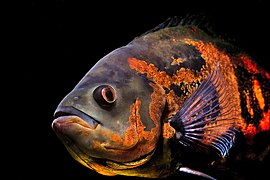
-

Salmo salar (Salmon Larva)
-

-
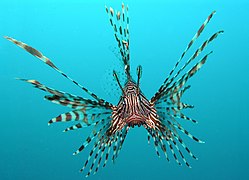
-

-
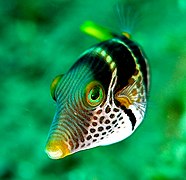
Canthigaster valentini (Valentinni'due south sharpnose puffer)
-

-
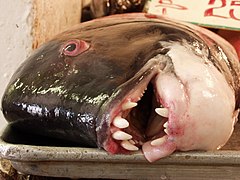
Semicossyphus pulcher (California Sheephead)
-

Pseudorasbora parva (Topmouth gudgeon)
-

Pterois antennata (Antennata Lionfish)
-
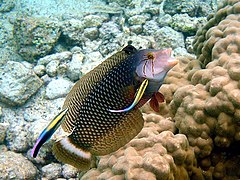
-
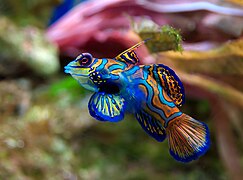
-
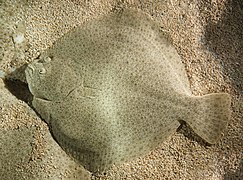
-

Examples of the other modes:
mode="traditional"
-

-

Salmo salar (Salmon Larva)
-

mode="nolines"
-

-

Salmo salar (Salmon Larva)
-

style="packed"
-

-

Salmo salar (Salmon Larva)
-

mode="packed-overlay"
style="packed-hover"
-

-

Salmo salar (Salmon Larva)
-

| MediaWiki version: | ≥ one.28 |
style="slideshow"
Optional gallery attributes
The gallery tag itself takes several additional parameters, specified as attribute name-value pairs:
< gallery { parameters } > {images} </ gallery > -
caption="{caption}": (caption text betwixt double quotes for more than than a word) sets a explanation centered atop the gallery. Just plain text may be used in the caption; formatting, templates and the like will not work. -
widths={width}px: sets the (max) widths of the images; the default value is 120px. Note the plural: widthsouthward . -
heights={heights}px: sets the (max) heights of the images; the default value is 120px. -
perrow={integer}: sets the number of images per row. 0 means automatically adjust based on width of screen. -
showfilename={annihilation}: Bear witness the filenames of the images in the individual captions for each image (i.17+). -
fashion={traditional|nolines|packed|packed-hover|packed-overlay|slideshow}: See section above (1.22+; one.28+ for "slideshow"). -
showthumbnails: For "slideshow" mode simply, display the strip with paradigm thumbnails beneath the slideshow past default (i.29+).
The widths and heights parameters are taken more as suggestions than strict values for packed (and related) modes. Packed modes will adjust the width of images in gild to make each row the same length.
- Example 1
Syntax:
< gallery widths = 300px heights = 200px > File:Example.jpg|Lorem ipsum File:Example.jpg|Lorem ipsum dolor sit amet, consetetur sadipscing elitr, sed diam nonumy eirmod tempor invidunt ut </ gallery > Result:
-
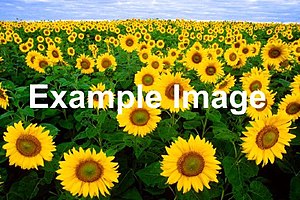
Lorem ipsum
-

Lorem ipsum dolor sit amet, consetetur sadipscing elitr, sed diam nonumy eirmod tempor invidunt ut
- Case 2
Syntax:
< gallery widths = 60px heights = 60px perrow = 7 caption = "sunflowers are groovy" > File:Case.jpg File:Case.jpg File:Example.jpg File:Example.jpg File:Example.jpg File:Instance.jpg File:Example.jpg File:Case.jpg File:Instance.jpg File:Example.jpg </ gallery > Event:
- sunflowers are nifty
-

-

-

-

-

-

-

-

-

-

Row of images that volition wrap to browser width
Ane style that works for a row of images with varying widths is not to use "thumb" or "left" or "none". If "thumb" is not used (and thus no captions) a row of images will wrap to the browser width. If necessary, narrow the browser window to encounter the images wrap to the adjacent row.
[[File:Example.jpg|220px]] [[File:Example.jpg|100px]] [[File:Instance.jpg|150px]] [[File:Example.jpg|250px]] [[File:Instance.jpg|200px]] [[File:Example.jpg|50px]] [[File:Example.jpg|220px]] [[File:Example.jpg|175px]]




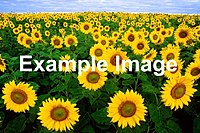
![]()


To wrap images of varying widths with captions information technology is necessary to use div HTML for an unordered listing. Along with style="display: inline-block;". For more info and ideas see: Give Floats the Moving picture in CSS Layouts.
< div >< ul > < li style = "display: inline-block;" > [[File:Case.jpg|thumb|none|220px|Caption one]] </ li > < li mode = "brandish: inline-block;" > [[File:Example.jpg|thumb|none|100px|Caption 2]] </ li > < li style = "brandish: inline-block;" > [[File:Example.jpg|thumb|none|150px|Caption three]] </ li > < li style = "brandish: inline-block;" > [[File:Example.jpg|pollex|none|250px|Caption 4]] </ li > < li fashion = "display: inline-block;" > [[File:Case.jpg|thumb|none|200px|Caption 5]] </ li > < li style = "brandish: inline-block;" > [[File:Example.jpg|thumb|none|50px|Explanation six]] </ li > < li style = "display: inline-block;" > [[File:Example.jpg|thumb|none|220px|Caption 7]] </ li > < li style = "display: inline-cake;" > [[File:Instance.jpg|thumb|none|175px|Caption eight]] </ li > </ ul ></ div > To align the top border of images add the vertical-align command
< div >< ul > < li style = "display: inline-block; vertical-align: elevation;" > [[File:Example.jpg|pollex|none|220px|Caption 1]] </ li > < li style = "display: inline-block; vertical-align: top;" > [[File:Example.jpg|pollex|none|100px|Caption two]] </ li > < li manner = "brandish: inline-block; vertical-align: summit;" > [[File:Example.jpg|pollex|none|150px|Explanation 3]] </ li > < li style = "display: inline-block; vertical-align: top;" > [[File:Example.jpg|thumb|none|250px|Caption iv]] </ li > < li mode = "display: inline-block; vertical-align: top;" > [[File:Case.jpg|thumb|none|200px|Explanation five]] </ li > < li style = "display: inline-block; vertical-marshal: top;" > [[File:Instance.jpg|thumb|none|50px|Caption 6]] </ li > < li style = "display: inline-cake; vertical-align: tiptop;" > [[File:Example.jpg|thumb|none|220px|Caption vii]] </ li > < li style = "display: inline-cake; vertical-align: top;" > [[File:Example.jpg|pollex|none|175px|Caption 8]] </ li > </ ul ></ div > Some wiki farms practice not have all gallery options (such as "widths"). Also, sometimes 1 wants varying widths for images in a row. Outside of a gallery, or the div HTML, it is incommunicable to have individual captions for images in a row of images that will wrap to the browser width. Attempt it and run into. Null else using wikitext works correctly. Images will either overlap stuff on the right, or force a horizontal scroll bar.
Using a left float ("left") for some images, combined with "none" for some of the images, will not work consistently either, peculiarly if there is also a correct sidebar of images. Weird things will occur. At narrower browser or screen widths an image out of the row may announced far down the page after the end of the right sidebar of images.
Link behavior
By default an image links to its file clarification page. The "link=" option modifies this beliefs to link to another page or website, or to turn off the image's linking behavior.
Alternatively, yous can create a text link to a file description page or to the file itself. Encounter Assist:Linking to files .
Display image, link information technology to another page or website
Use "link=" option to link image to some other folio or website:
Clicking on the below image volition have y'all to MediaWiki:
[[File:MediaWiki-2020-logo.svg|50px|link=MediaWiki]]

Clicking on the beneath image will take yous to example.com:
[[File:MediaWiki-2020-logo.svg|50px|link=http://example.com]]

Brandish image, turn off link
Utilize "link=" selection with no value assigned to turn link off entirely; the below image is non a link:
[[File:MediaWiki-2020-logo.svg|50px|link=]]

Link to an image
Add together : as a prefix to the link y'all need to create.
[[:File:MediaWiki-2020-logo.svg]]
File:MediaWiki-2020-logo.svg
[[:File:MediaWiki-2020-logo.svg|Wiki]]
Wiki
Directly linking to an image
The above examples link to the paradigm's description page. To directly link to an image, the pseudo-namespace Media: can be used on MediaWiki pages:
[[Media:MediaWiki-2020-logo.svg]] Media:MediaWiki-2020-logo.svg
Direct links from external sites
Another possibility is to use the Special:Redirect/file page (or its alias Special:Filepath). Unlike the above example, you can link to it from external websites as well as from MediaWiki pages.
[[Special:Redirect/file/Wikipedia.png]] The parameters height and width can also be added to return a specific size of the paradigm. The image aspect ratio is always preserved.
https://www.mediawiki.org/due west/index.php?title=Special:Redirect/file/Wikipedia.png&width=100&height=100 Obtaining the full URL of an paradigm
To obtain the full path of an image (without going through redirects as shown above), some Magic words tin exist used.
{{filepath:MediaWiki-2020-logo.svg}} Becomes:
- //upload.wikimedia.org/wikipedia/eatables/d/dd/MediaWiki-2020-logo.svg
In the event that this is used from a template where the File: namespace needs to be removed, {{PAGENAME}} can do so:
{{filepath:{{PAGENAME:File:MediaWiki-2020-logo.svg}}}} Becomes:
- //upload.wikimedia.org/wikipedia/commons/d/dd/MediaWiki-2020-logo.svg
Requisites
Before using images in your page, the system ambassador of your wiki must have enabled file uploads and a user has to upload the file. System administrators may also set the wiki to take files from foreign repositories, such equally the Wikimedia Commons. For server side epitome resizing it is necessary to have a scaler configured (such equally GD2, ImageMagick, etc.).
Files at other websites
You can link to an external file available online using the aforementioned syntax used for linking to an external web folio. With these syntaxes, the image will not exist rendered, but only the text of the link to this epitome will exist displayed.
[http://url.for/some/prototype.png]
Or with a dissimilar displayed text:
[http://url.for/some/paradigm.png link text hither]
Boosted MediaWiki markup or HTML/CSS formatting (for inline elements) is permitted in this displayed text (except for embedded links that would interruption the surrounding link):
[http://www.instance.com/some/epitome.png Example '''<del>rich</del>''' ''<ins>link text</ins>'' hither.]
which renders as: Instance rich link text here.
If it is enabled on your wiki (see Manual:$wgAllowExternalImages ), you can also embed external images. To do that, simply insert the prototype's URL:
http://url.for/some/image.png
Embedded images tin be resized by the CSS transform property. They also may be formatted by surrounding MediaWiki markup or HTML/CSS lawmaking.
If this wiki option is not enabled, the image will non be embedded but rendered as a textual link to the external site, just like above, unless the site's Manual:$wgAllowExternalImagesFrom has a value.
See likewise
- Wikipedia:Extended image syntax
- Category:Wikipedia prototype help
- Wikipedia:Picture tutorial
- west:Aid:Gallery tag
- Manual:Adding support for new filetypes
- phab:T113101 - responsive issues
- Extension:PageImages#Tin can I exclude certain page images?
Source: https://www.mediawiki.org/wiki/Help:Images/en












0 Response to "Can We Upload File on Semantic Media Wiki?"
Post a Comment